|
|
 |
Fiche d'espèce de Copépode |
|
|
Calanoida ( Ordre ) |
|
|
|
Arietelloidea ( Superfamille ) |
|
|
|
Heterorhabdidae ( Famille ) |
|
|
|
Heterostylites ( Genre ) |
|
|
| |
Heterostylites major (F. Dahl, 1894) (F,M) | |
| | | | | | | Syn.: | Heterochaeta major F. Dahl,1894;
Heterorhabdus major : Giesbrecht & Schmeil, 1898 (p.117); Wolfenden, 1905 a (p.11); van Breemen, 1908 a (p.227);
Alloiorhabdus medius Wolfenden, 1911 (p.306, figs.F); Cépède, 1914 a (p.150);
Heterochaeta zetesios Wolfenden in Fowler, 1903 (p.124, Descr.M);
Heterorhabdus longicornis Wolfenden, 1908 (p.38, Rem.M); Farran, 1908 b (p.67, Rem.);
? no Heterostylites major: Vervoort, 1951 (p.140, fig.M, Rem.);
? no Heterorhabdus nigrotinctus Brady,1918 (p.27, Rem.M, figs.M); | | | | Ref.: | | | Sars, 1925 (p.239, figs.F); Farran, 1929 (p.209, 267, Rem.); Sewell, 1932 (p.302, Rem.); Rose, 1933 a (p.208, fig.F); Jespersen, 1934 (p.108, Rem., figs.M); Hardy & Gunther, 1935 (p.182, Rem.: ?); Jespersen, 1940 (p.56, Rem.); Lysholm & al., 1945 (p.37); Sewell, 1948 (p.514, Rem.); Farran, 1948 d (n°15, p.3) Davis, 1949 (p.61: Rem.); Brodsky, 1950 (1967) (p.358, figs.F,M); Vervoort, 1957 (p.135, fig.F, Rem.); Tanaka, 1964 a (p.25, Descr.M, figs.M); Vervoort, 1965 (p.123, Rem.); Minoda, 1971 (p.40); Heptner, 1971 (p.158, Rem.F,M); Bradford, 1971 b (p.26, fig.M); Shih & al., 1971 (p.204); Björnberg & al., 1981 (p.650, figs.F); Gardner & Szabo, 1982 (p.380, figs.F, M); Razouls, 1994 (p.166, fig.F); Chihara & Murano, 1997 (p.817, Pl.117: F,M); Ohtsuka & al., 1997 (p.579, figs.F,M); Bradford-Grieve & al., 1999 (p.883, 945, figs.F,M); Bradford-Grieve,1999 b (p.89: Rem.); Park, 2000 (p.40, figs.F,M, Rem.); Vives & Shmeleva, 2007 (p.314, figs.F,M, Rem.) |  issued from : Vervoort W. in B.A.N.Z. Antarctic Research Expedition 1929-1931, 1957, B. 3. Copepods. [Fig.127]. Female (from 65°08'S, 80°58'E): left P5 (posterior aspect).
|
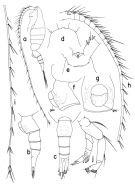 issued from : T. Park Bull. Scripps Inst. Oceanogr. Univ. California, San Diego, 2000, 31. [p.170, Fig.18].
Female: a, habitus (left side); b, c, urosome (left, dorsal, respectively); d, e, forehead (dorsal, ventral, respectively); f, g, genital somite (left, ventral, respectively); h, segments 1-16 of left A1 (ventral); i, segments 17-25 of left A1 (ventral); j, left A2 (posterior). geo = genital operculum.
Nota: Prosome length 2.68-3.41 mm.
|
 issued from : T. Park Bull. Scripps Inst. Oceanogr. Univ. California, San Diego, 2000, 31. [p.171, Fig.19].
Female: a, left Md (posterior); b, masticatory edge of left Md (posterior); c, masticatory edge of right Md (posterior); d, left Mx1 (posterior); e, left Mx2 (posterior); f, right Mxp (anterior); g, P1; h, P2; i, P3; j, P4; k, P5. P1-5 = swimming legs 1-5 (anterior)
|
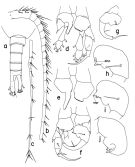 issued from : T. Park Bull. Scripps Inst. Oceanogr. Univ. California, San Diego, 2000, 31. [p.172, Fig.20].
Male: a, urosome (dorsal); b, segments 1-16 of left A1 (ventral); c, segments 17-25 of left A1 (ventral); d, P5 (with distal segments of right exopod omitted), anterior; e, basipods of P5 (anterior); f, P5 (with endopods omitted), posterior; g, exopod of right P5 (anterior); h, second exopodal segment of right P5 (posterior); i, idem (tilted counterclockwise); j, idem (anterior). dmc = distomedial corner; mpr = medial projection.
|
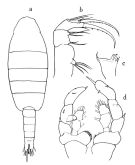 issued from : O. Tanaka in Publs Seto Mar. Biol. Lab., 1964, XII (1). [p.25, Fig.186]. Male: a, urosome (dorsal); b, Mx1; c, biting edge of Md; d, P1; e, P5; f, inner margin of 2nd segment oexopod of right P5. Nota: The urosome segments and furca are in the proportional lengths as 17:15:17:12:12:27 (left) = 100. Left A1 exceeds the end of the furca by distal 7 segments. Right A1 forms a grasping organ.
|
 Issued from : G.O. Sars in Résult. Camp. Scient. Prince Albert I, 69, pls.1-127 (1924). [Pl.LXVII, figs.17-18]. Female (from around Azores Islands & Bay of Biscay): 17, habitus (dorsal view); 18, terminal segments of A1. Nota: A1 exceeding 1/3 body length. Nota: compare the four last segments of A1 with H. longicornis ones.
|
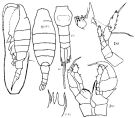 Issued from : K.A. Brodskii in Calanoida of the Far Eastern Seas and Polar Basin of the USSR. Opred. Fauna SSSR, 1950, 35 (Israel Program for Scientific Translations, Jerusalem, 1967) [p.359, Fig.252] Female (from NW Pacif.): habitus (dorsal and lateral left side); MRi, Md (biting edge, right side view): urosome (dorsal); H5, P5. Male: S5, P5.
|
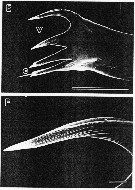 issued from : S. Ohtsuka, H.Y. Soh & S. Nishida in J. Crustacean Biol., 1997, 17 (4). [p.580, Fig.1, E, F]. Female (from S. Japan): E, right mandibular cutting edge; F, ventralmost tooth. v = ventral teeth; c = central teeth. Scale bars : 0.100 mm (E); 0.010 mm (F).
|
 issued from : S. Ohtsuka, H.Y. Soh & S. Nishida in J. Crustacean Biol., 1997, 17 (4). [p.583, Fig.4, E]. Male (S Japan): E, left side of labrum (posterior surface) with gland openings (small arrow). Scale bar: 0.010 mm.
|
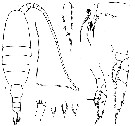 issued from : R.N. Wolfenden in Die Marinen Copepoden der Deutschen Südpolar-Expedition 1901-1903, 1911. [p.307, Fig.55]. As Alloiorhabdus medius. Female: a, habitus (dorsal); b, Mxp; c, Md (biting edge); d, P1 (distal segment of endopod); e, P2 (distal segment of endopod); f, P4 (distal segment of endopod); g, P3 (distal segment of exopod); h, P4; i, P5.
|
 Heterostylites major Heterostylites major female: 1 - Dorsally, genital somite widest at middle. 2 - Ventrally, genital operculum much wider than 1/2 width of somite (Fig.18-g). 3 - Laterally, , ventral margin of genital somite extending straight beyond posterior end of genital operculum (Fig.18-f). 4 - Laterally, 2nd urosomal somite with swollen ventral margin; setae of mouthparts conspicuously plumose.
|
 Heterostylites major Heterostylites major male: 1 - Basal lobe of right P5 relatively short (Fig.20-e); basal lobe of left P5 low and wide. 2 - In 2nd exopodal segment of right P5, medial projection with a long serrated process (Fig.20-h). 3 - Setae of mouthparts highly plumose.
| | | | | Ref. compl.: | | | Hardy & Gunther, 1935 (1936) (p.182, Rem.: ?); Grice, 1963 a (p.496); Harding, 1974 (p.141, tab.2, gut contents); Deevey & Brooks, 1977 (p.256, tab.2, Station "S"); Buchanan & Sekerak, 1982 (p.41, vertical distribution); Chen Y.-Q., 1986 (p.205, Table 1: abundance %, Table 2: vertical distribution); Sameoyo, 1994 (p.213, Table 1); Ikeda & al., 2006 (p.1791, Table 2); Khelifi-Touhami & al., 2007 (p.327, Table 1); Schnack-Schiel & al., 2008 (p.1045: Tab.2); Gaard & al., 2008 (p.59, Table 1, N Mid-Atlantic Ridge); Galbraith, 2009 (pers. comm.); Homma & Yamaguchi, 2010 (p.965, Table 2); Homma & al., 2011 (p.29, Table 2, 3, 5, abundance); Abe & al., 2012 (p.100, temporal & vertical changes); Takenaka & al., 2012 (p.1669, fig.2, 3, Table 1, bioluminescence); Belmonte, 2018 (p.273, Table I: Italian zones) | | | | NZ: | 16 | | |
|
Carte de distribution de Heterostylites major par zones géographiques
|
| | | | | | | | | | | | | | | 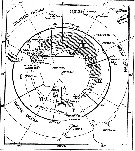 issued from : W. Vervoort in B.A.N.Z. Antarctic Reseach Expedition, Reports - Ser. B, Vol. III, 1957 [Fig.124] issued from : W. Vervoort in B.A.N.Z. Antarctic Reseach Expedition, Reports - Ser. B, Vol. III, 1957 [Fig.124]
Chart showing the geographical distribution (white triangle) in the seas surrounding the Antarctic continent.
Nota: In this chart the area frequented by whaling vessels has been hatched. The Antarctic circle (66°.5 S) has been drawn as a broken line. The numbers I to VI refer to the sectors into which the Antarctic seas are divided according to Mackintosh (1942) (after Vervoort, 1951). |
| | | | Loc: | | | Antarct. (Weddell Sea, SE Atlant., Indian, SW Pacif., Ross Sea), ? South Georgia, sub-Antarct. (Indian), South Africa, Atlant. (tropical), G. of Guinea, Cape Verde Is., off Morocco-Mauritania, Canary Is., Brazil, G. of Mexico, Florida, off Bermuda (Station "S"), Sargasso Sea, off Cape Cod, Hudson Strait, Davis Strait, W Baffin Bay, Baffin Sea, Iceland, Faroe Is., Norwegian Sea, off SW Ireland, North Sea, Ibero-moroccan Bay, W Medit. (El Kala shelf, Tyrrhenian Sea), Indian, Philippines, Japan (Izu, off Sanriku, off E Hokkaido), Station Knot, Kuril-Kamchatka, Okhotsk Sea, Bering Sea, S Aleutian Basin, S Aleutian Is., Pacif. central (sub-arct.), G. of Alaska, Icy Strait, Chile (N & S).
Type locality: Atlantic (location ?) | | | | N: | 57 | | | | Lg.: | | | (1) F: 4,7; (10) F: 5,2; (16) F: 4,1-4; M: 3,96-3,8; (22) F: 5,2-4,7; M: 5,1-4,5; (23) F: 5,75-4,9; M: 5,5-4,05; (25) F: 5,4-4,55; M: 5,09-4,14; (35) F: 4,92; M: 4,26; (44) F: 5; (49’) F: 4,8; (102) M: 4,5; (121) M: 5,38; (199) M: 4,5-4,18; (208) F: 5; M: 5; (824) F: 5-4; M: 5,16-4,12; {F: 4,00-5,75; M: 3,75-5,50} | | | | Rem.: | méso-bathypélagique.
Sampling depth (Antarct., sub-Antarct.) : 200-600 m.
Pour Sewell (1932; 1948) les deux espèces seraient synonymes. Seules les dimensions permettent de distinguer cette espèce de H. longicornis. Des confusions ont été possibles avec Heterostylites nigrotinctus, d'où certaines localisations contestables. Park (2000) et Ohtsuka & al. (1997, p.593: Notes) ne sont pas en accord sur la synonymie entre cette espèce et Heterostylites nigrotinctus.
Certaines localisations nécessitent confirmation (Park, 2000)
Voir aussi les remarques en anglais | | | Dernière mise à jour : 16/11/2020 | |
|
|
 Toute utilisation de ce site pour une publication sera mentionnée avec la référence suivante : Toute utilisation de ce site pour une publication sera mentionnée avec la référence suivante :
Razouls C., Desreumaux N., Kouwenberg J. et de Bovée F., 2005-2025. - Biodiversité des Copépodes planctoniques marins (morphologie, répartition géographique et données biologiques). Sorbonne Université, CNRS. Disponible sur http://copepodes.obs-banyuls.fr [Accédé le 28 novembre 2025] © copyright 2005-2025 Sorbonne Université, CNRS
|
|
 |
 |














